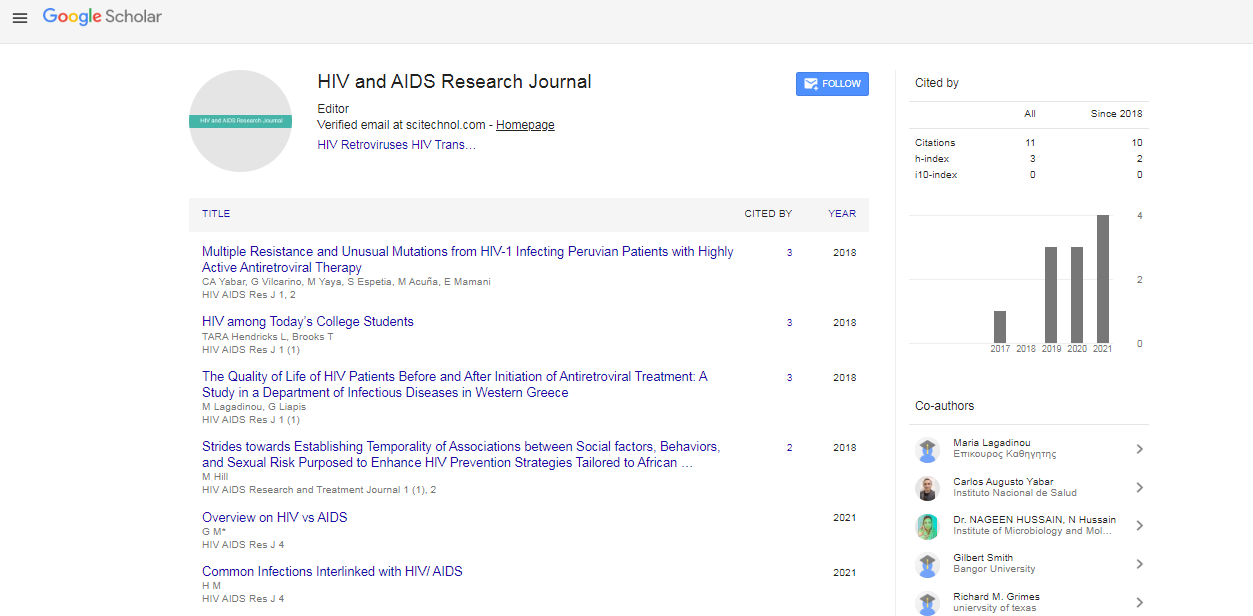Editorial, Hiv Aids Res Vol: 7 Issue: 1
Advances in HIV Treatment and Antiretroviral Therapy
Sneha Iyer*
Department of Medicine, Jawaharlal Institute of Postgraduate Medical Education & Research (JIPMER), Puducherry, India
- *Corresponding Author:
- Sneha Iyer
Department of Medicine, Jawaharlal Institute of Postgraduate Medical Education & Research (JIPMER), Puducherry, India
E-mail: sneha.iyer@jipmer.edu.in
Received: 01-Mar-2025, Manuscript No. HARJ-25-170194; Editor assigned: 4-Mar-2025, Pre-QC No. HARJ-25-170194 (PQ); Reviewed: 20-Mar-2025, QC No HARJ-25-170194; Revised: 26-Mar- 2025, Manuscript No. HARJ-25-170194 (R); Published: 30-Mar-2025, DOI: 10.4172/Harj.1000
Citation: Sneha Iyer, Department of Medicine, Jawaharlal Institute of Postgraduate Medical Education & Research (JIPMER), Puducherry, India. HIV AIDS Res J 7:1.
Copyright: © 2025 Sneha Iyer, this is an open-access article distributed under the terms of the Creative Commons Attribution License, which permits unrestricted use, distribution, and reproduction in any medium, provided the original author and source are credited.
INTRODUCTION
The advent of antiretroviral therapy (ART) has transformed HIV from a fatal disease into a manageable chronic condition. In India, free ART has been available since 2004 under NACO, benefiting millions of patients [1].
ART in India
Currently, more than 1.6 million PLHIV in India receive ART through over 600 centers nationwide [2]. First-line regimens typically include tenofovir, lamivudine, and dolutegravir. Studies show high levels of viral suppression among patients adherent to ART [3].
Emerging Therapies
Long-acting injectable ART and two-drug regimens are under evaluation to improve adherence. Research into broadly neutralizing antibodies and therapeutic vaccines also offers hope for functional cures [4].
CONCLUSION
While India has made significant progress in ART delivery, challenges remain in adherence, drug resistance, and pediatric HIV management. Strengthening adherence support and investing in research are key future priorities.
REFERENCES
- NACO. ART Guidelines for HIV Care. Govt of India, 2021.
- Sinha A. ART scale-up in India. Indian J Med Res. 2018;148: 701–710.
- Sahay S. Outcomes of ART in Indian patients. J Assoc Physicians India. 2017;65: 24–28.
- Gupta R. Long-acting ART: Indian perspective. Curr HIV/AIDS Rep. 2019;16: 437–444.
- Deshpande P. HIV drug resistance in India. Indian J Med Microbiol. 2020;38: 323–328.
 Spanish
Spanish  Chinese
Chinese  Russian
Russian  German
German  French
French  Japanese
Japanese  Portuguese
Portuguese  Hindi
Hindi 